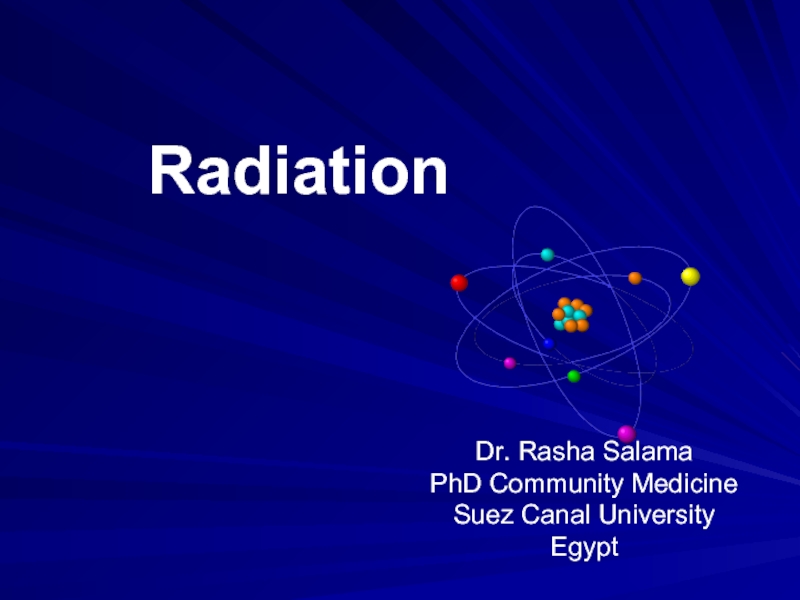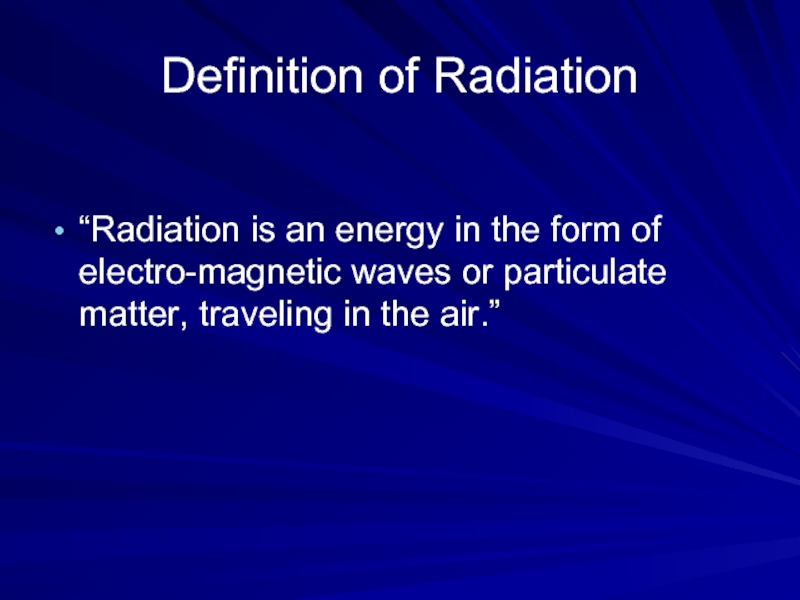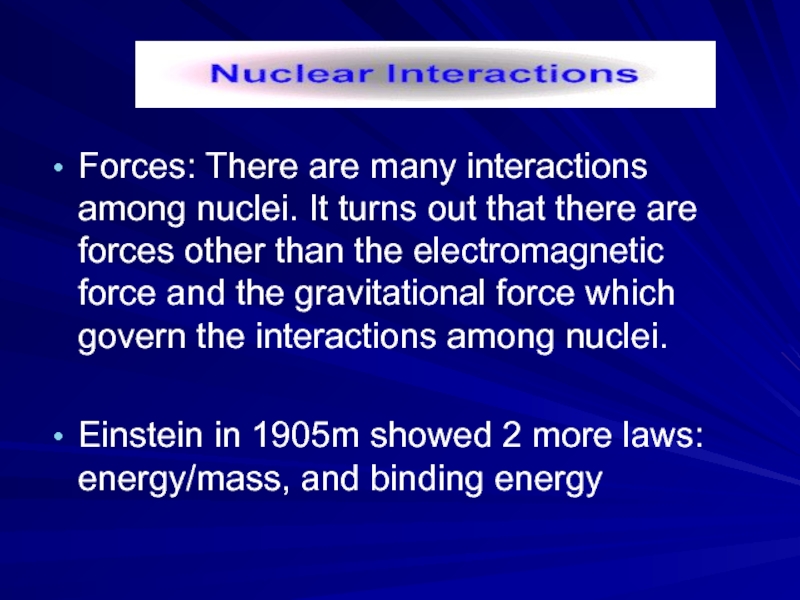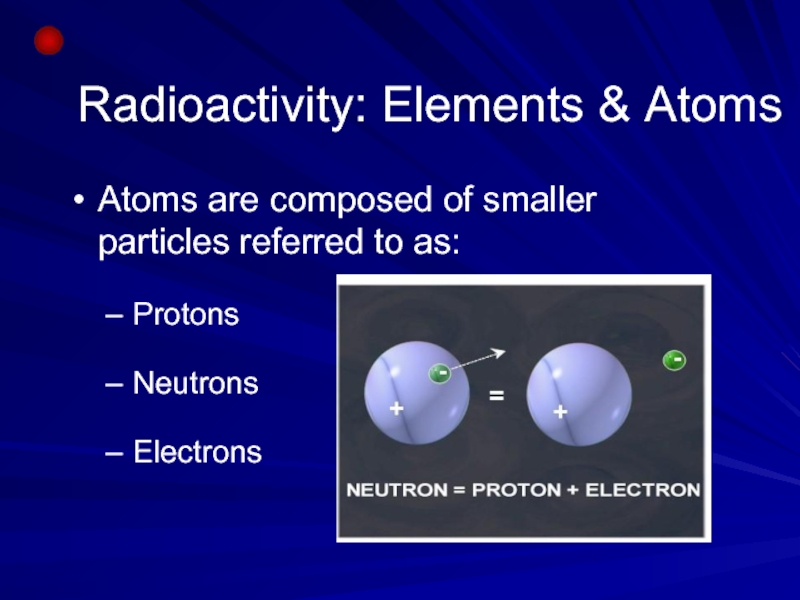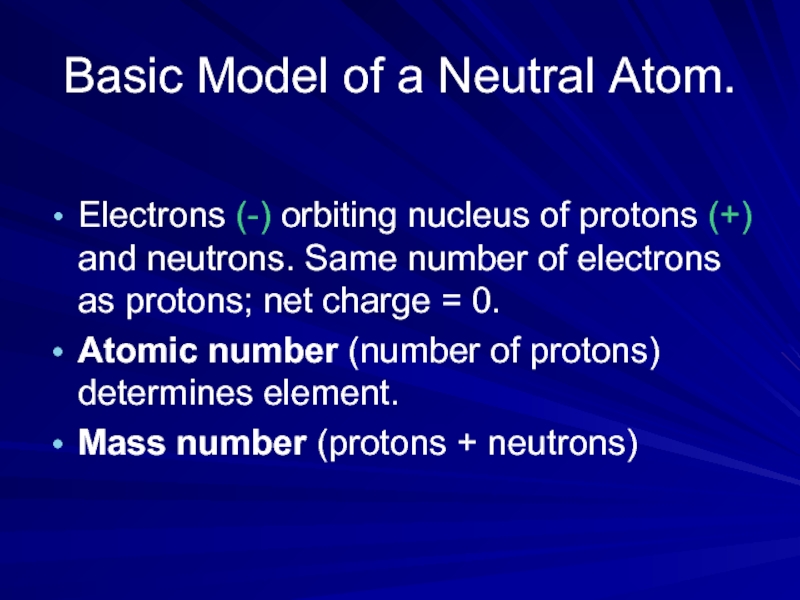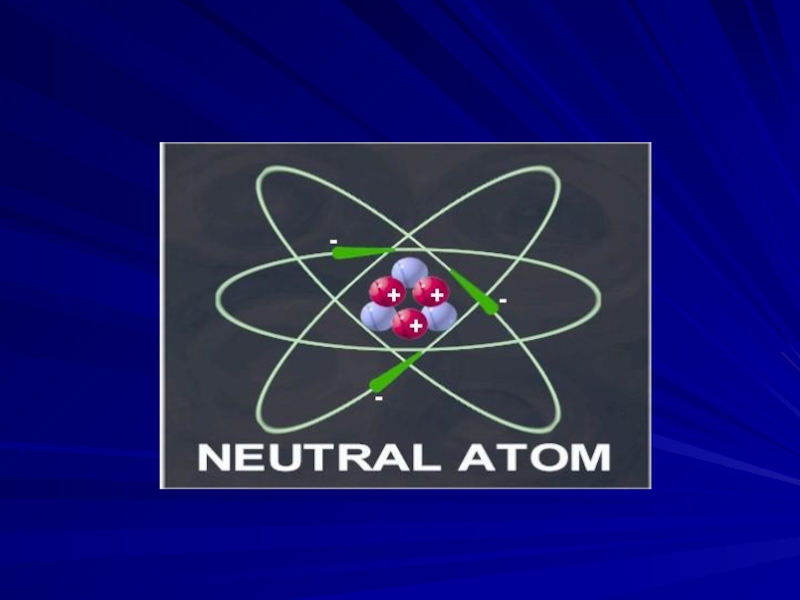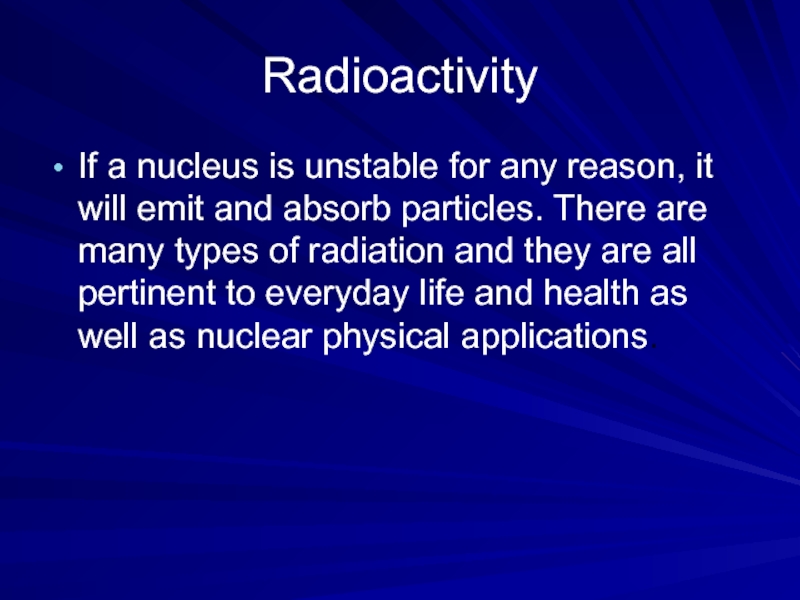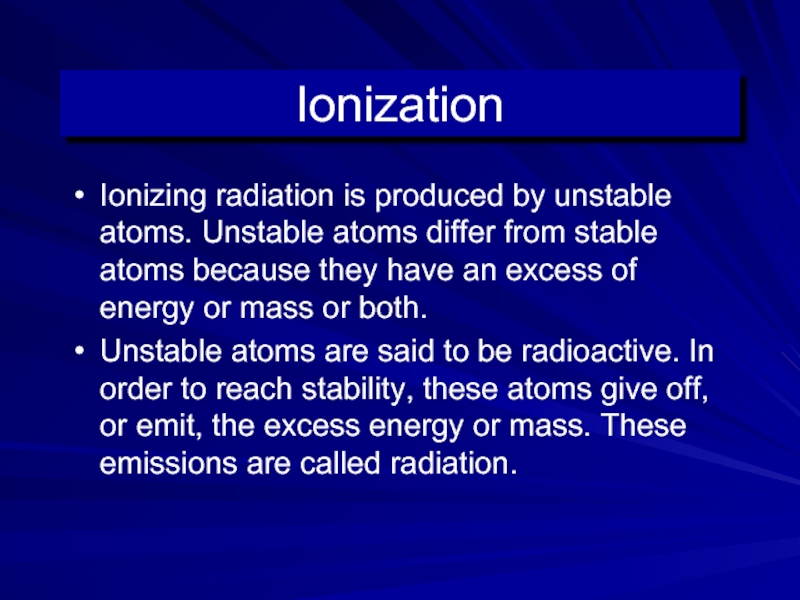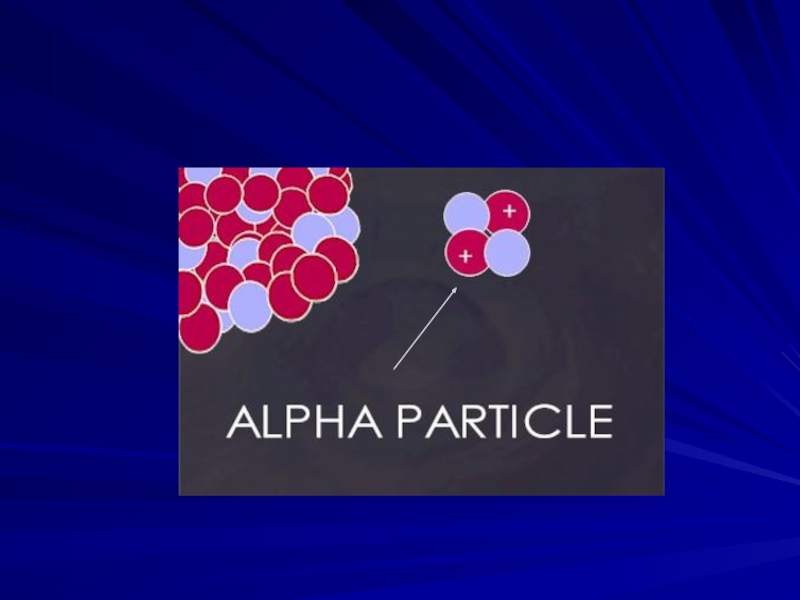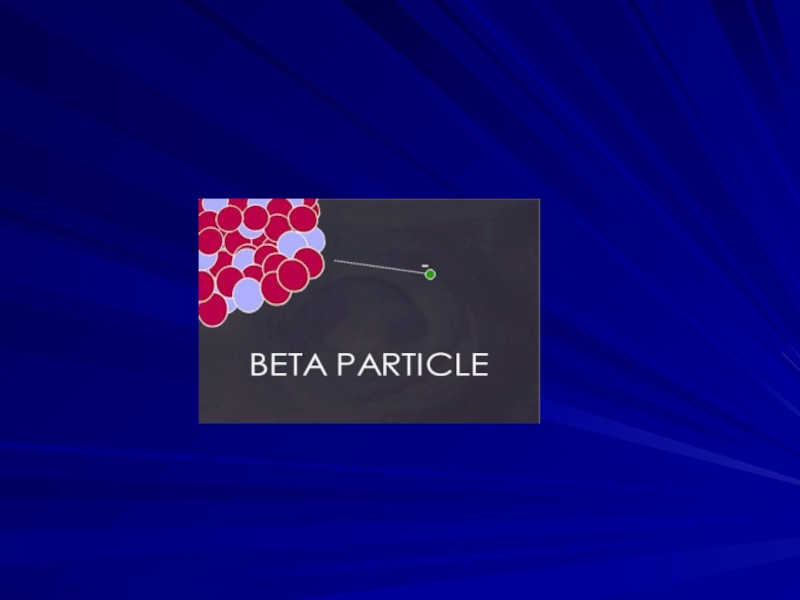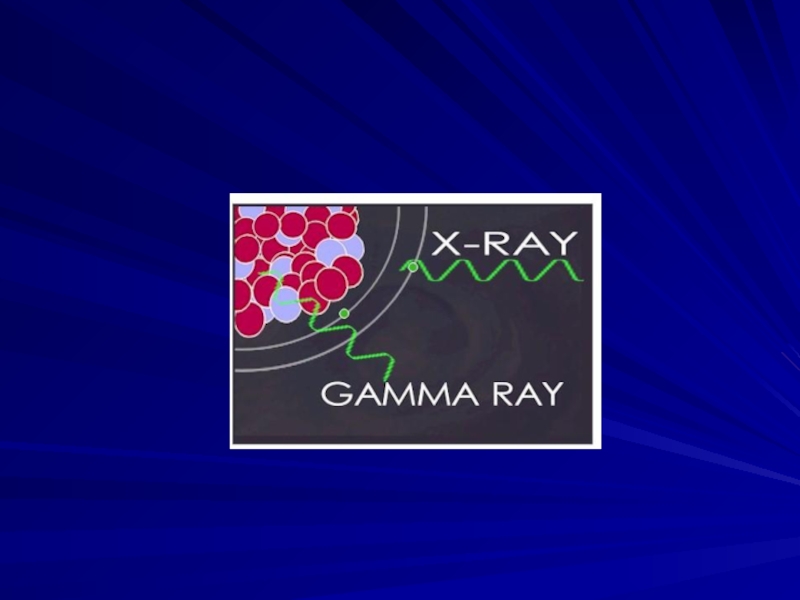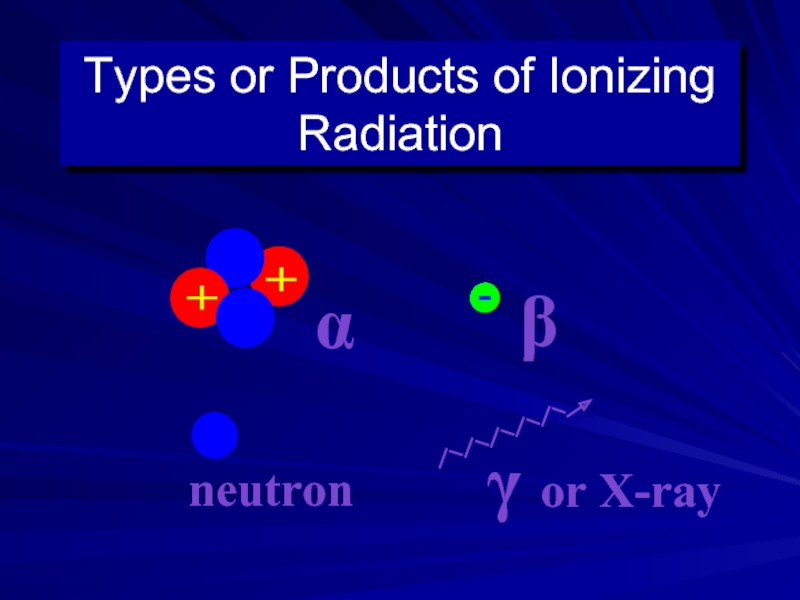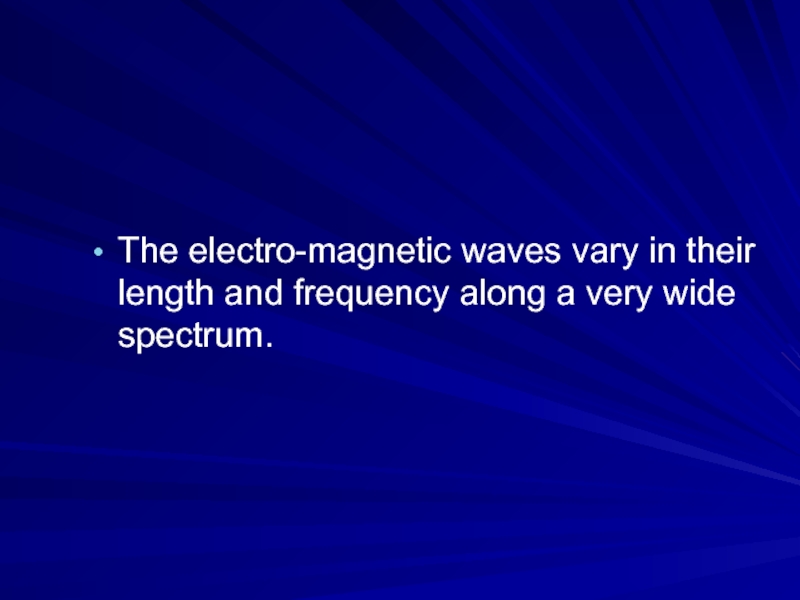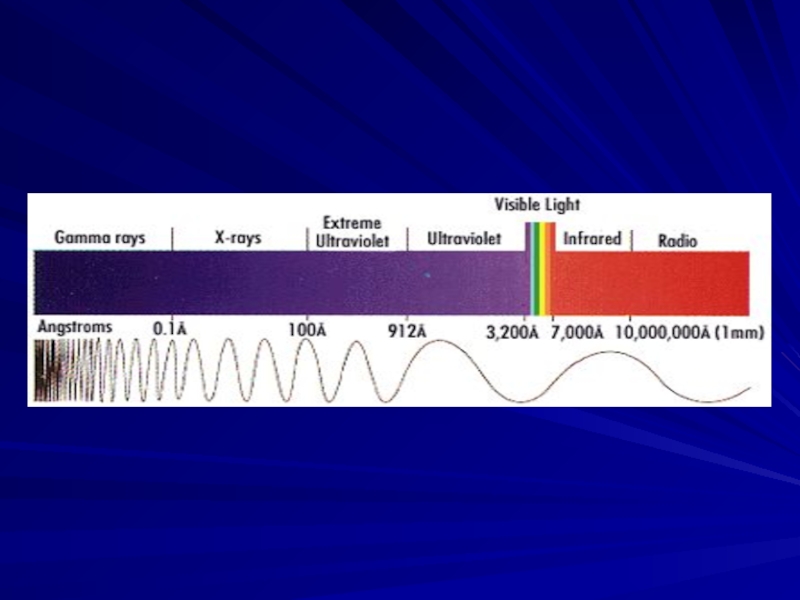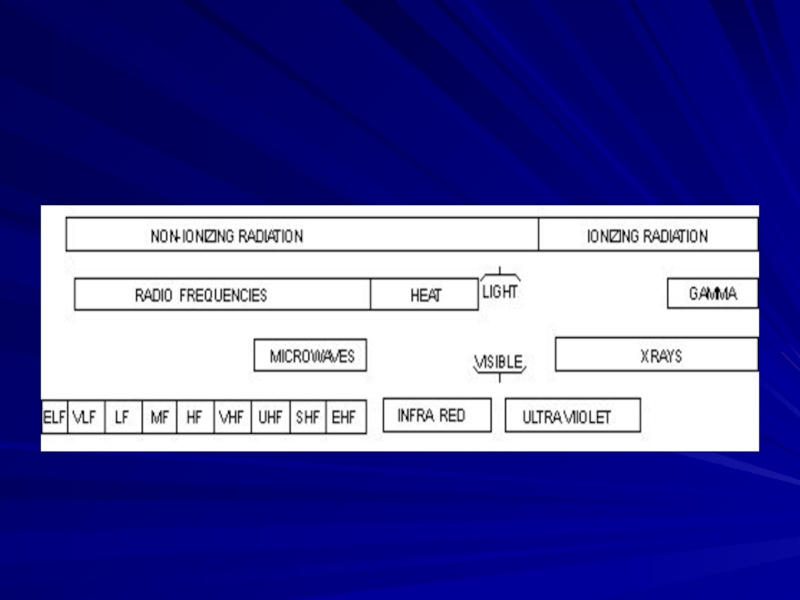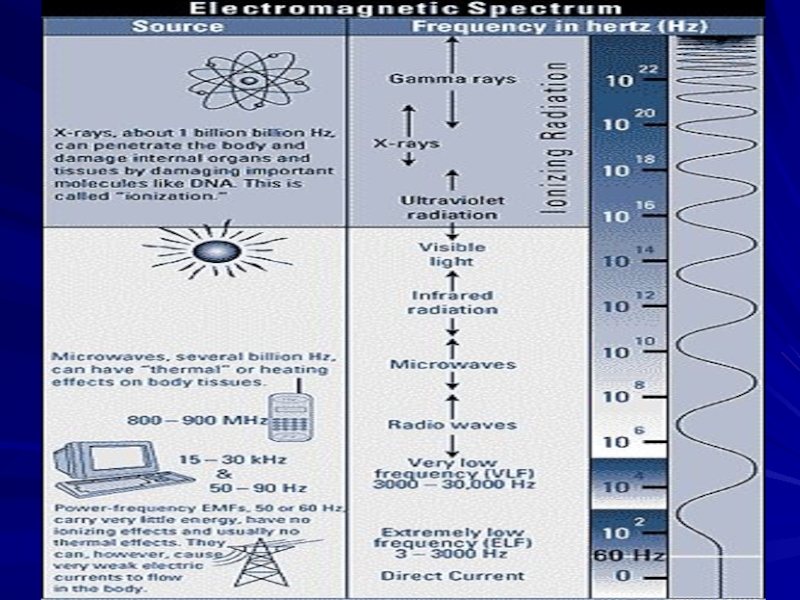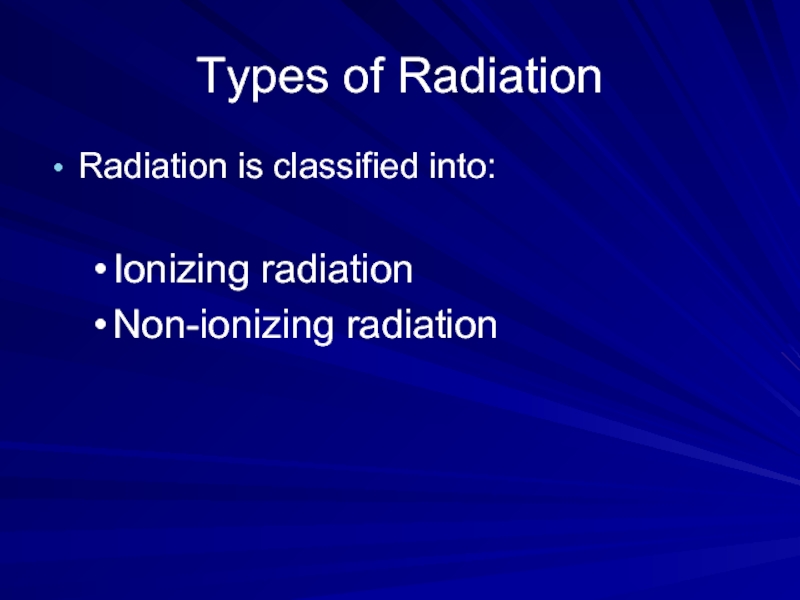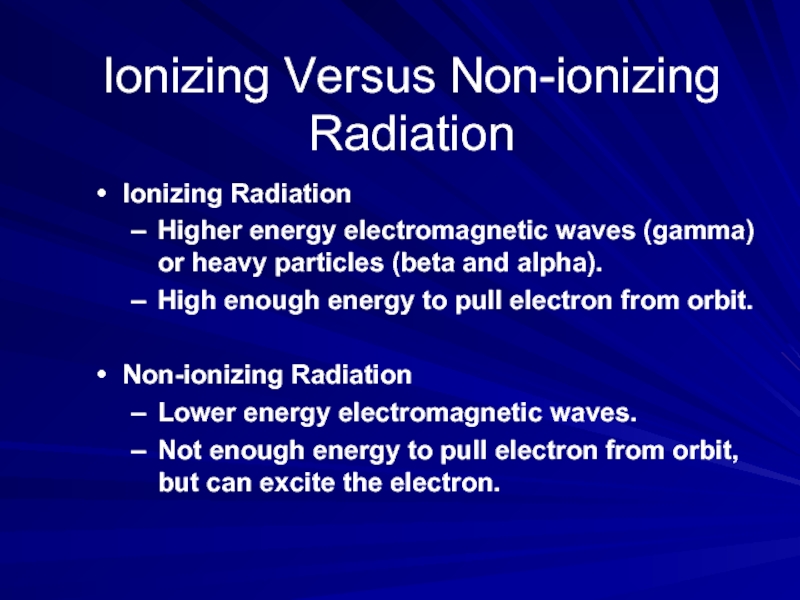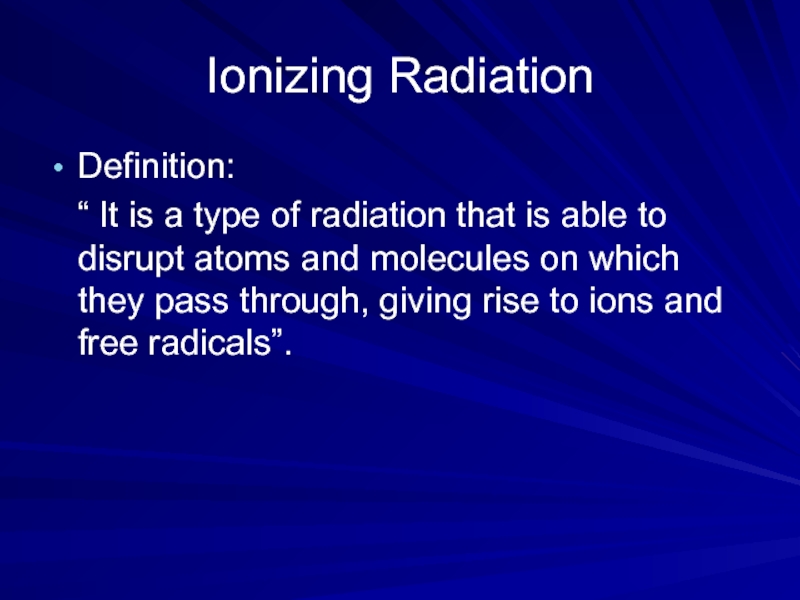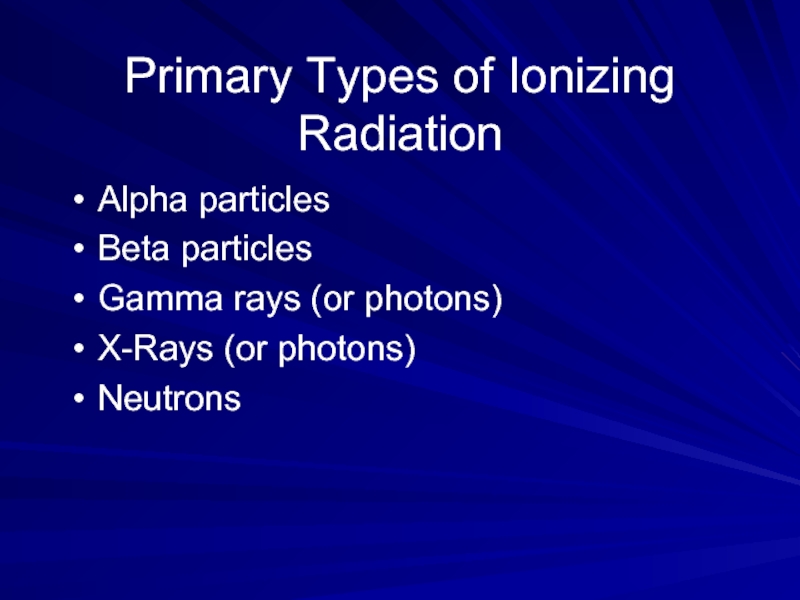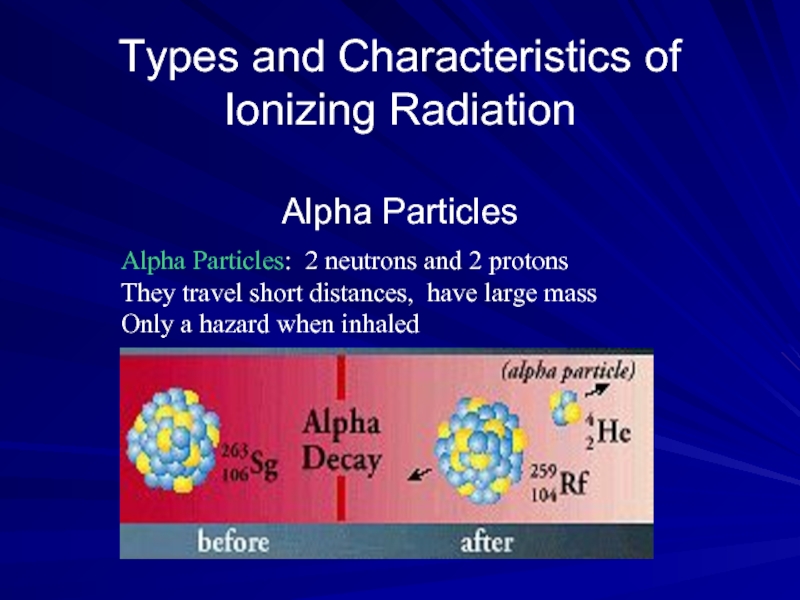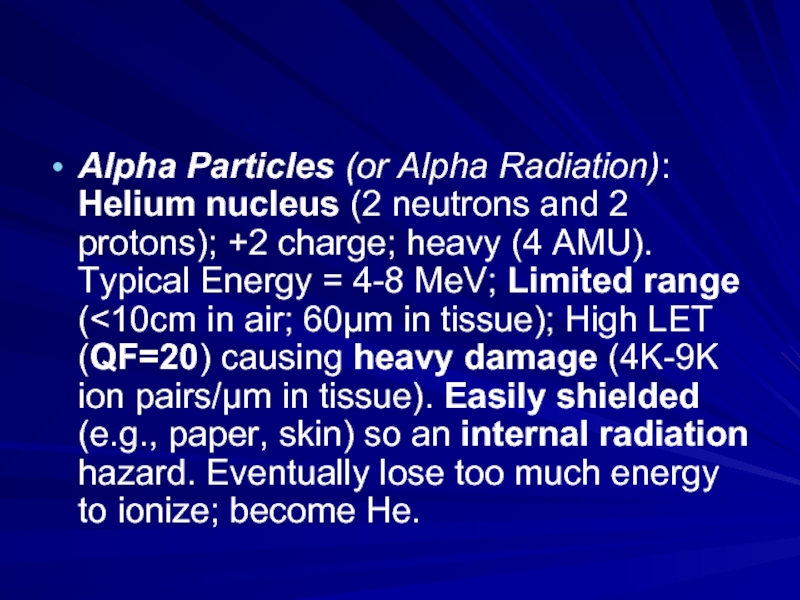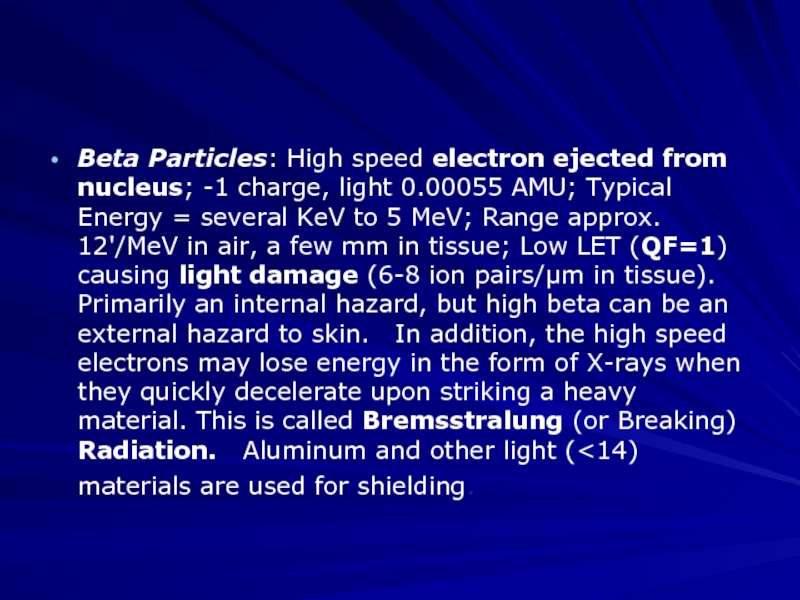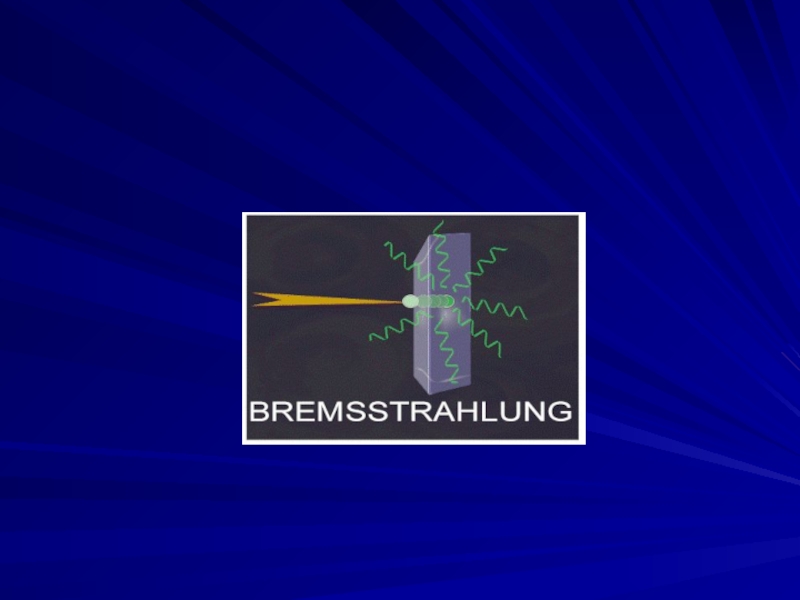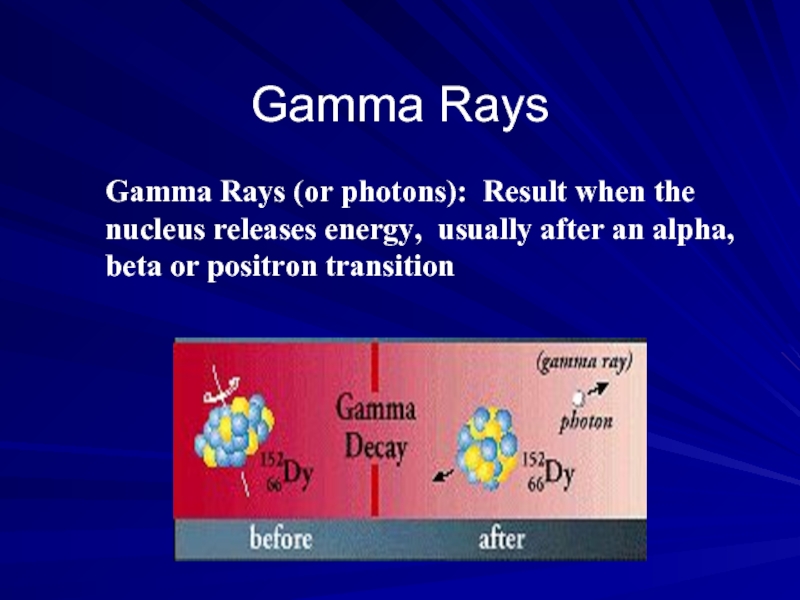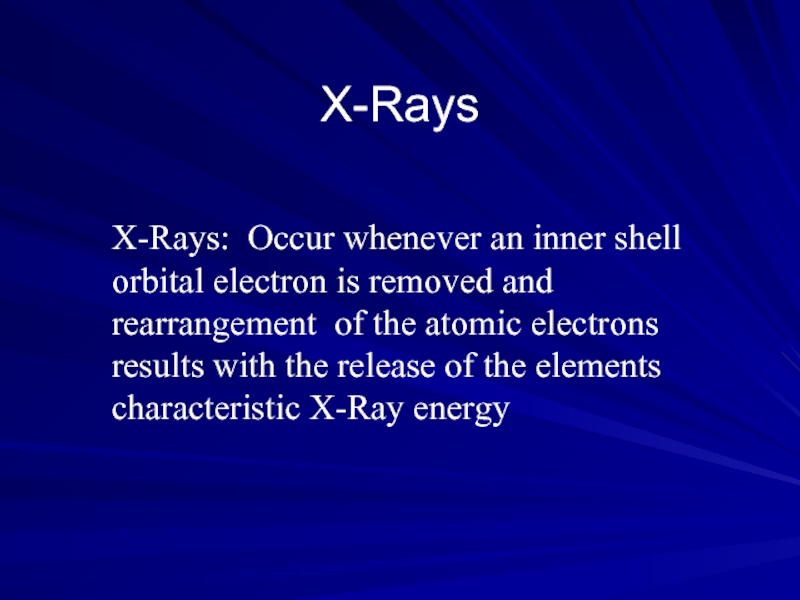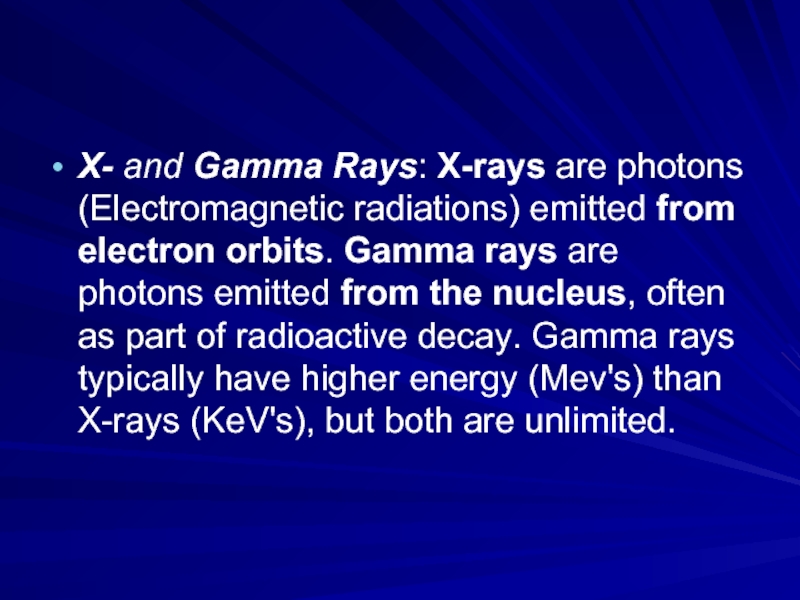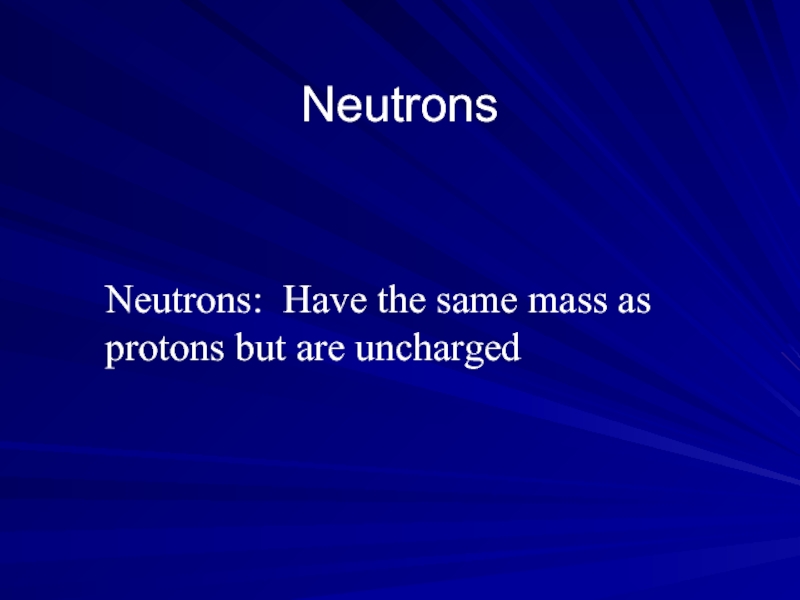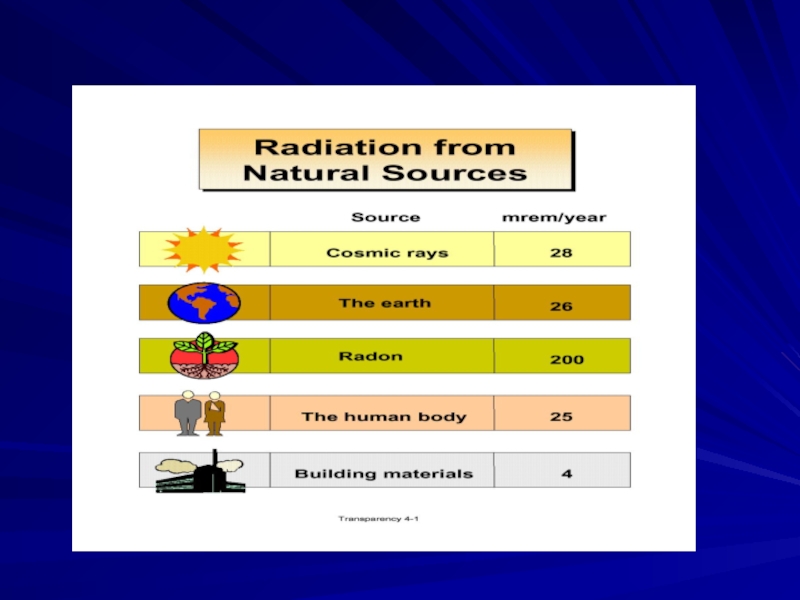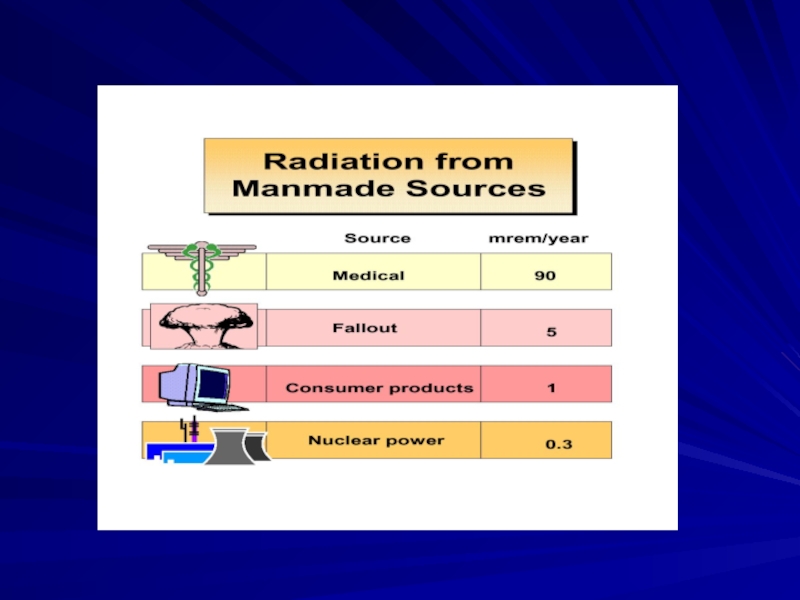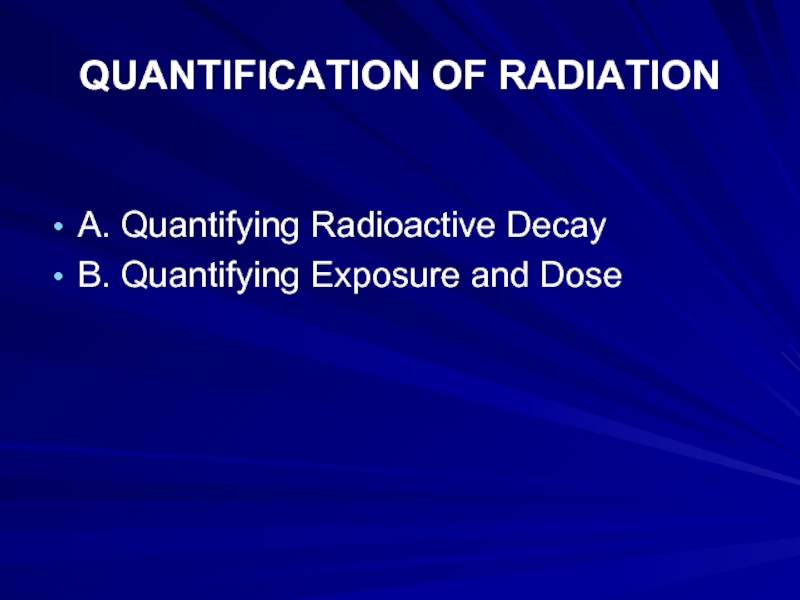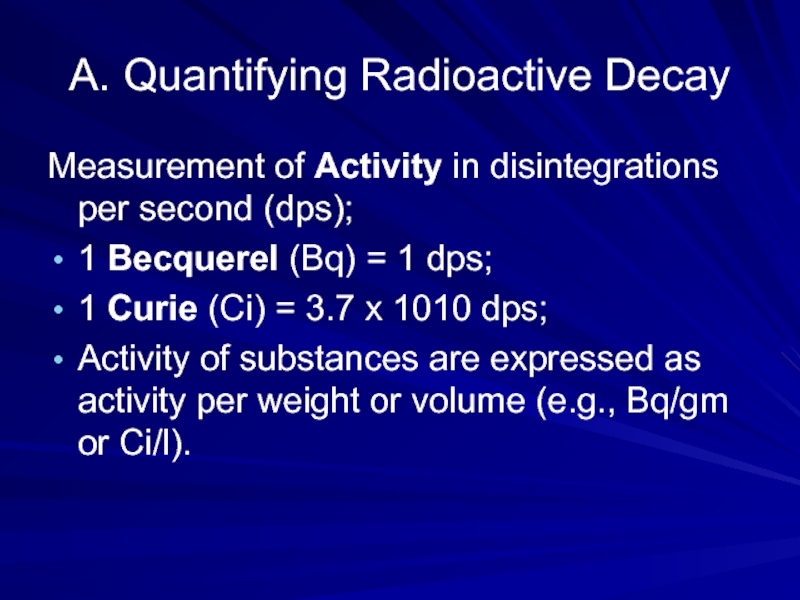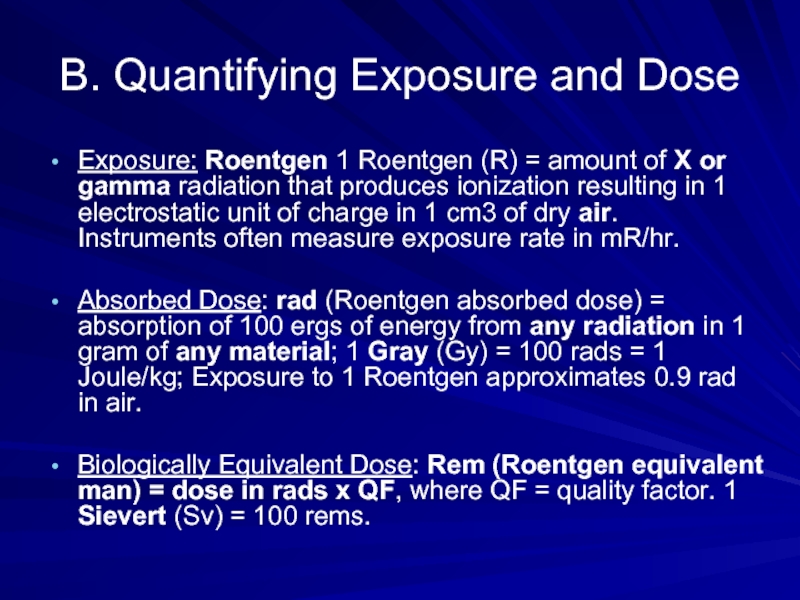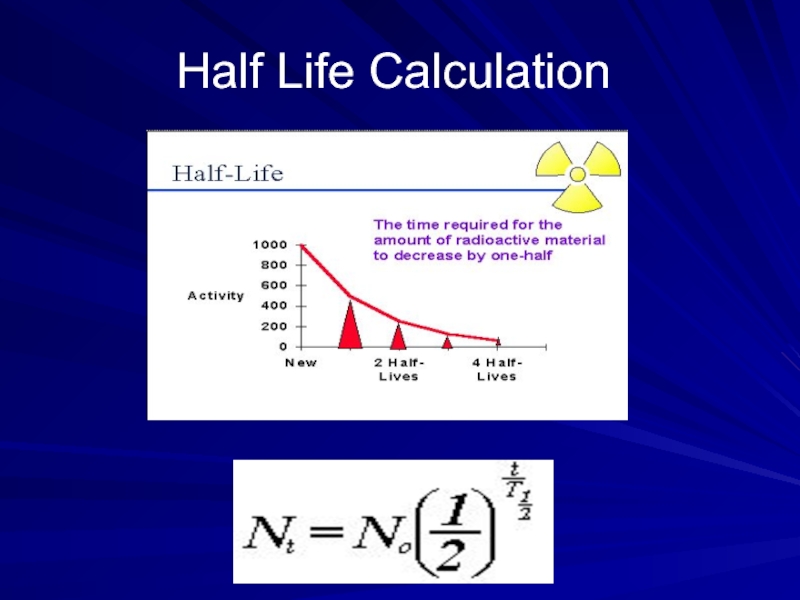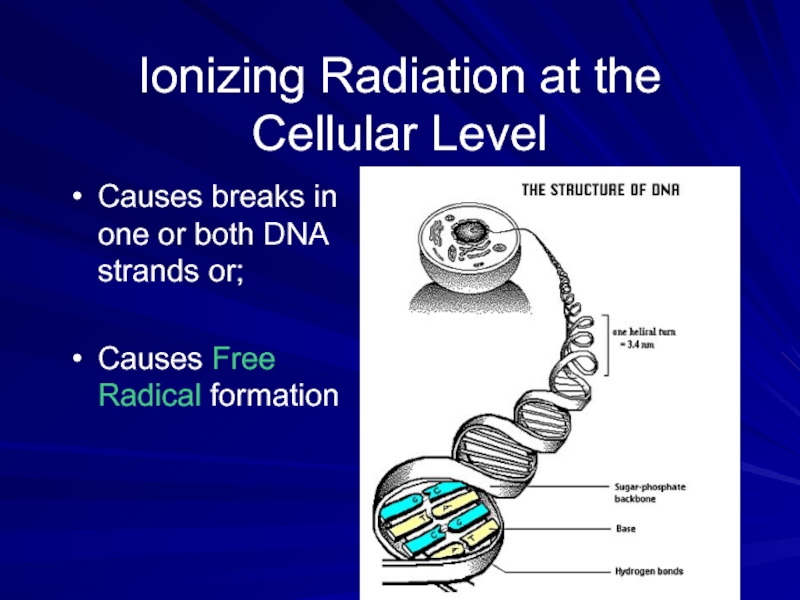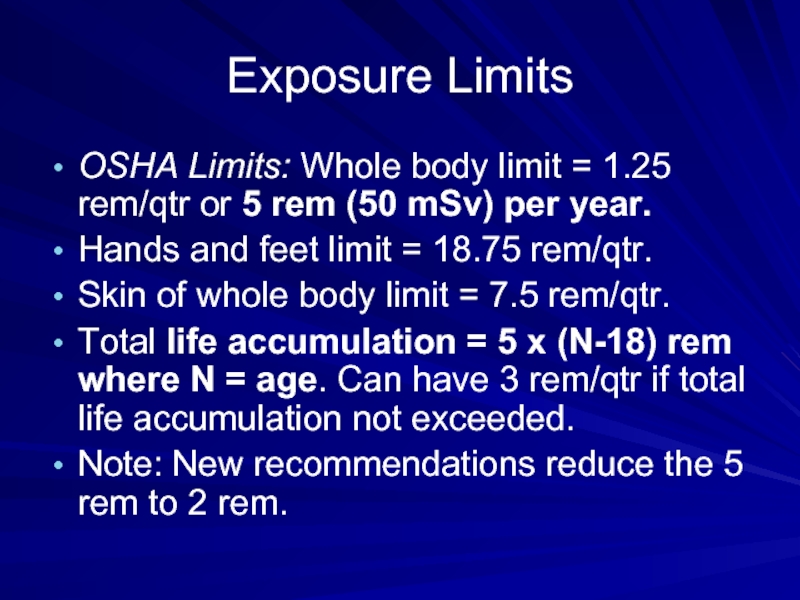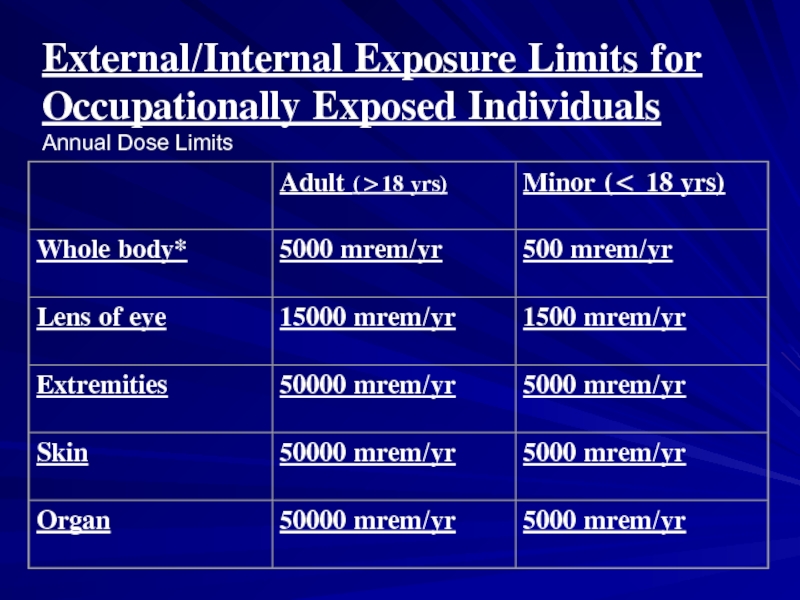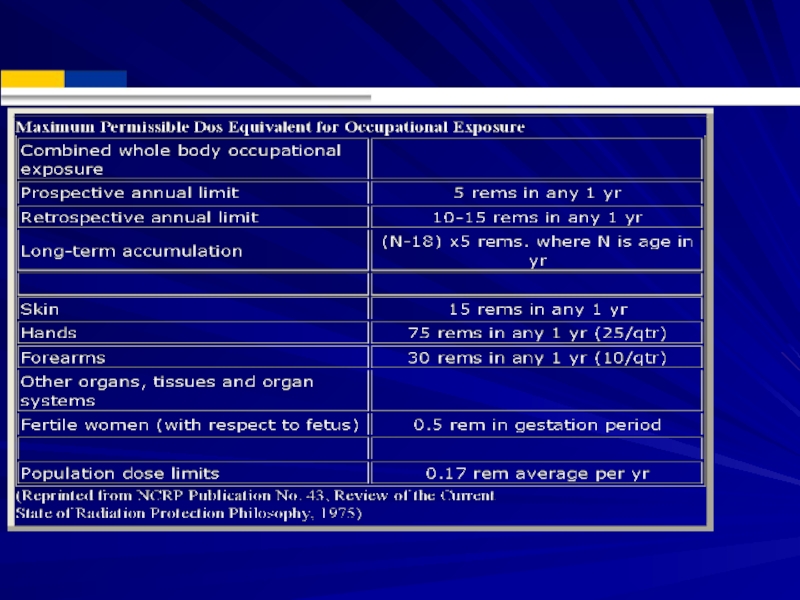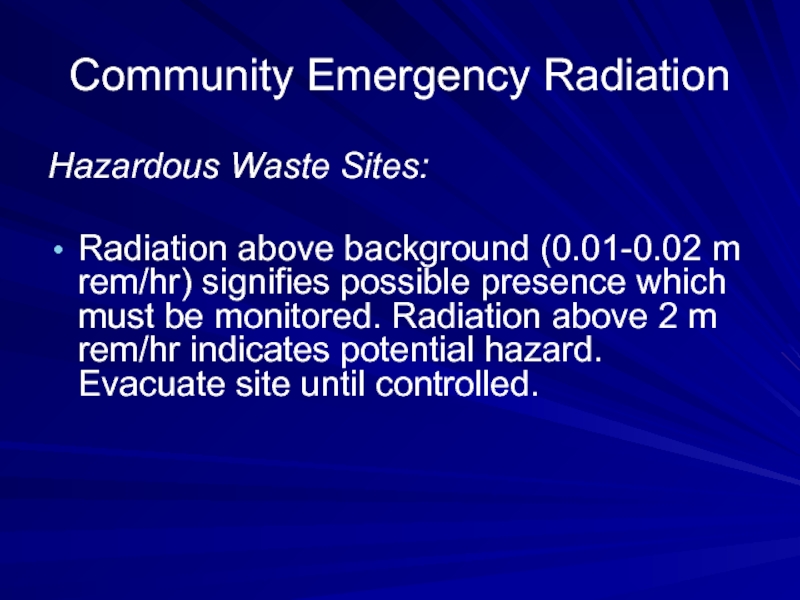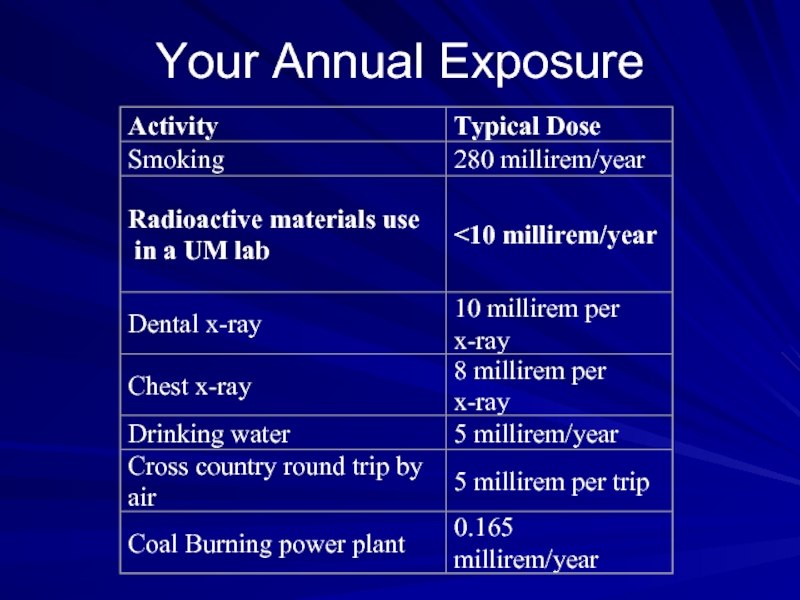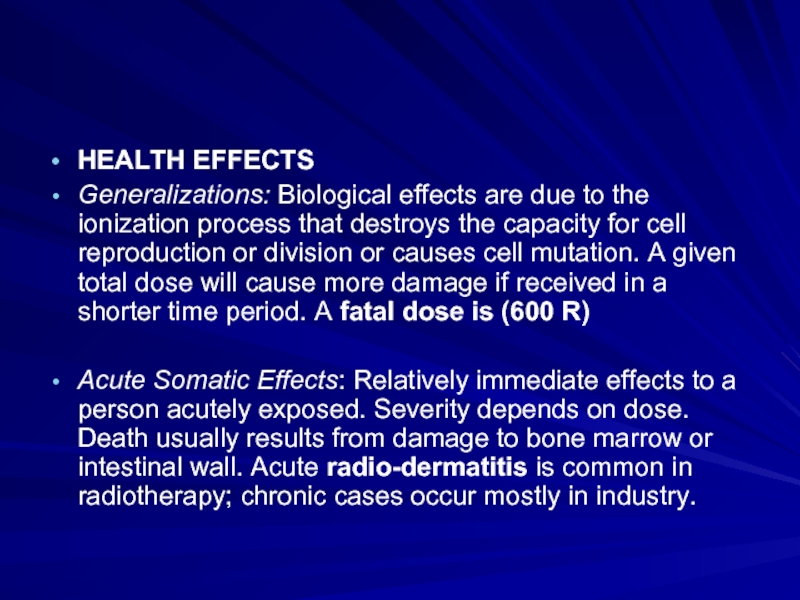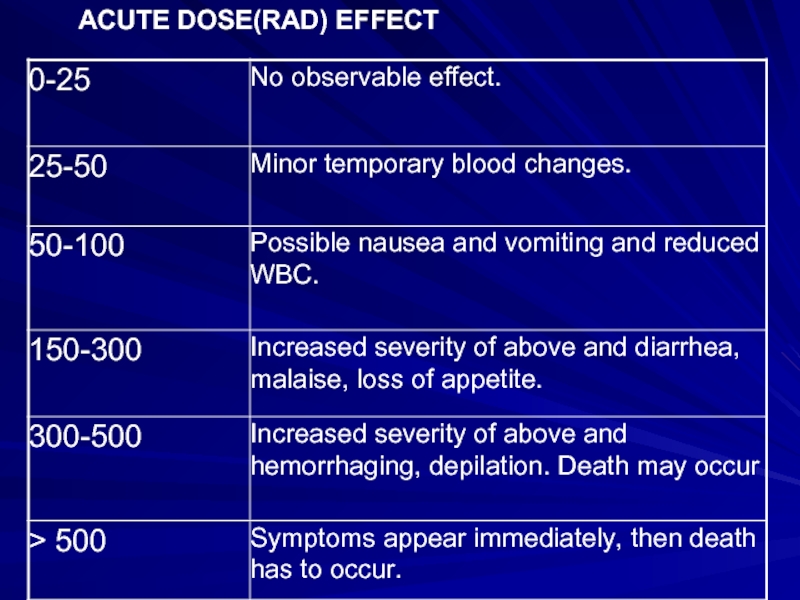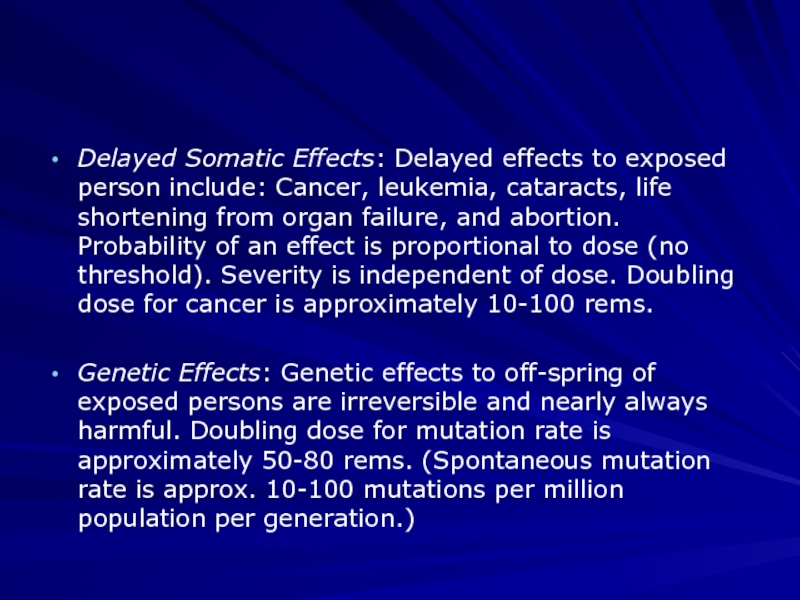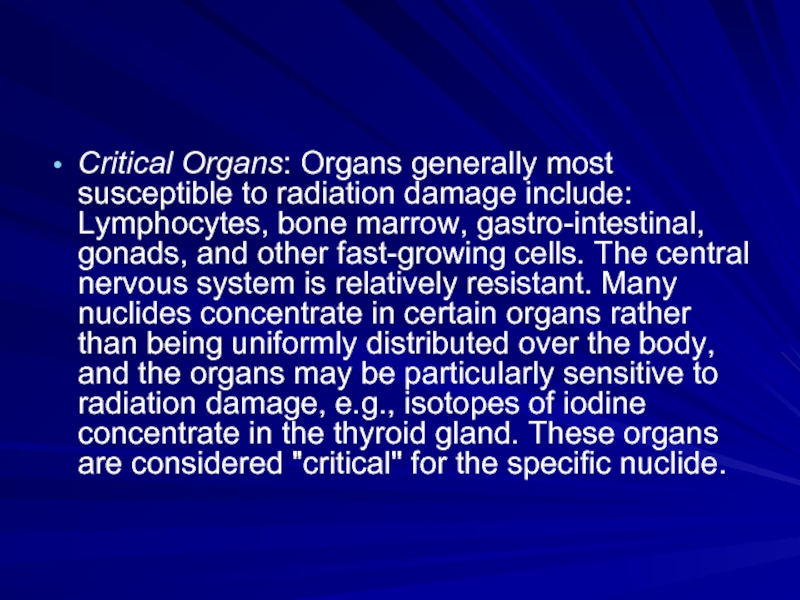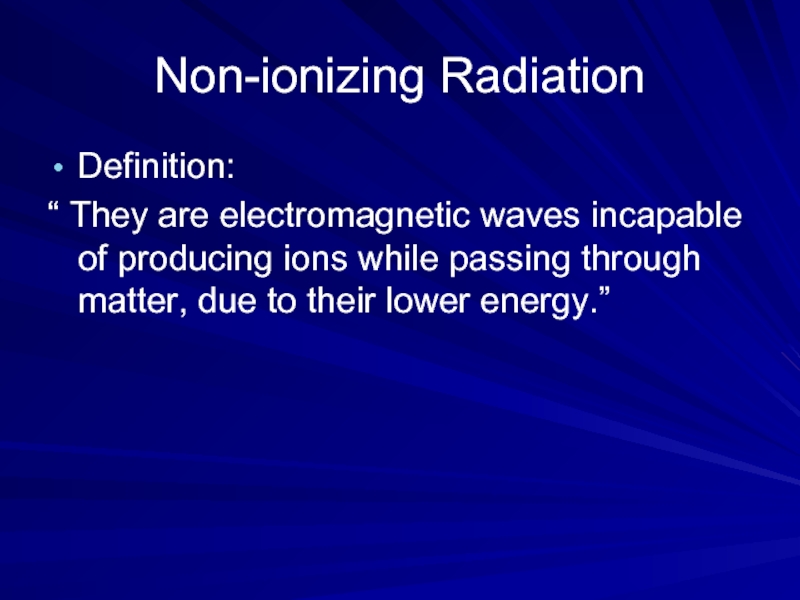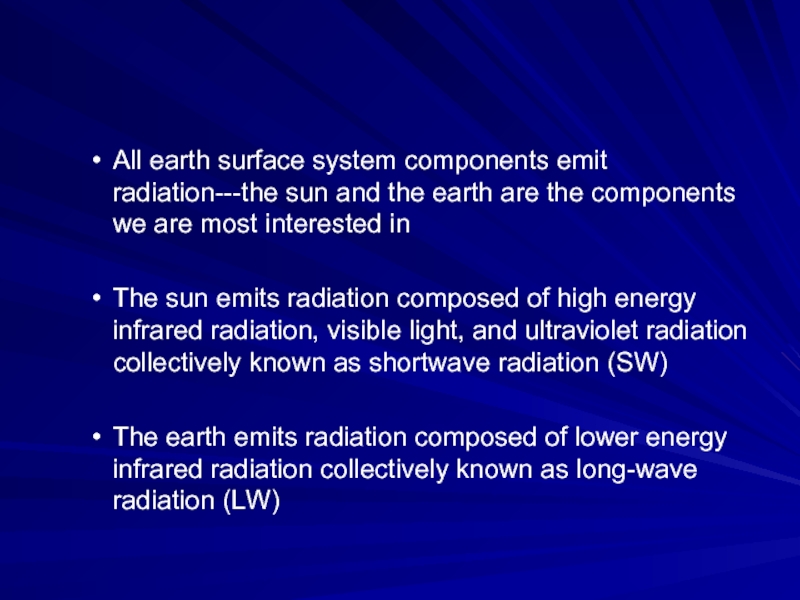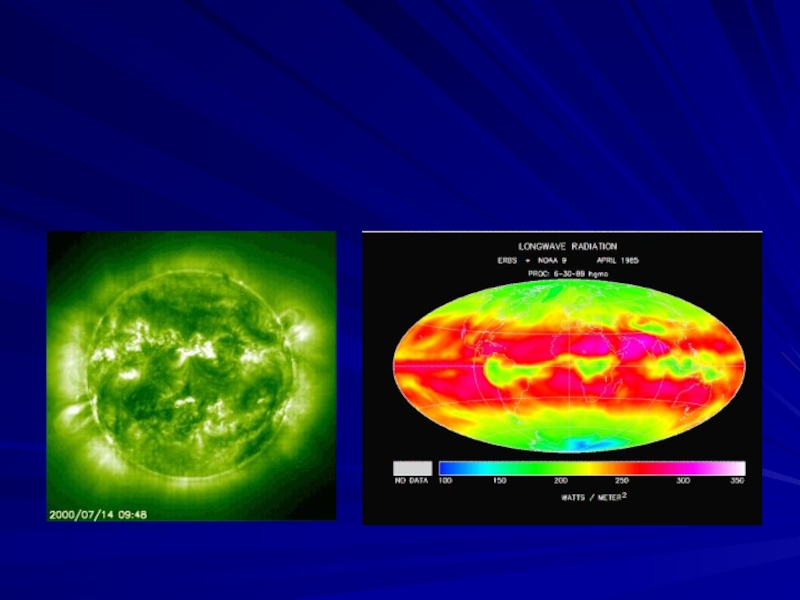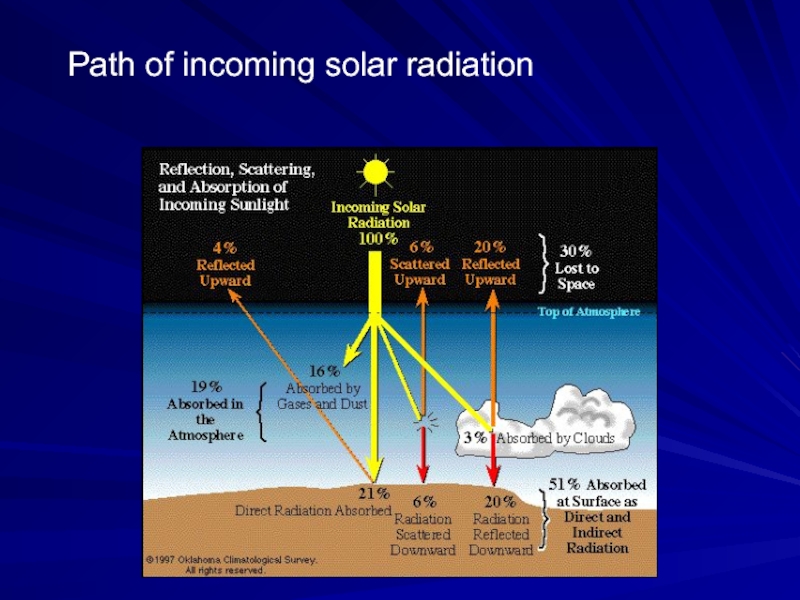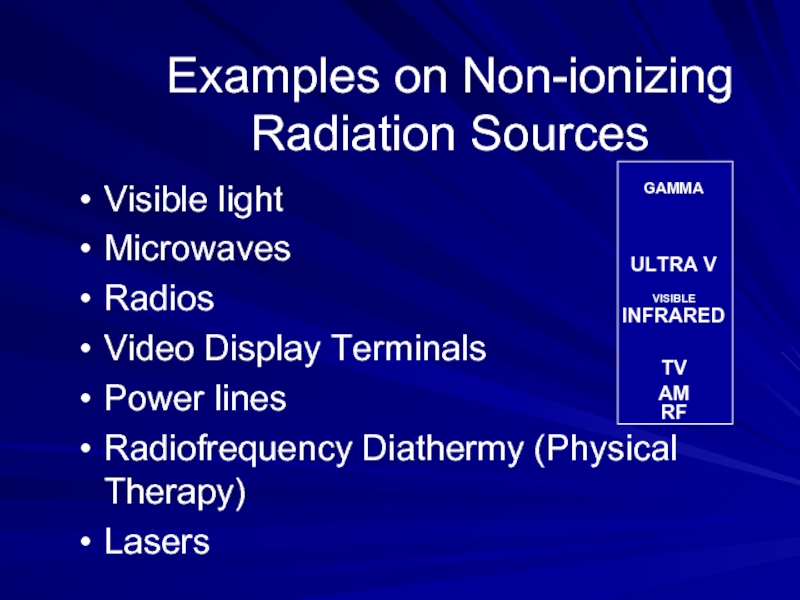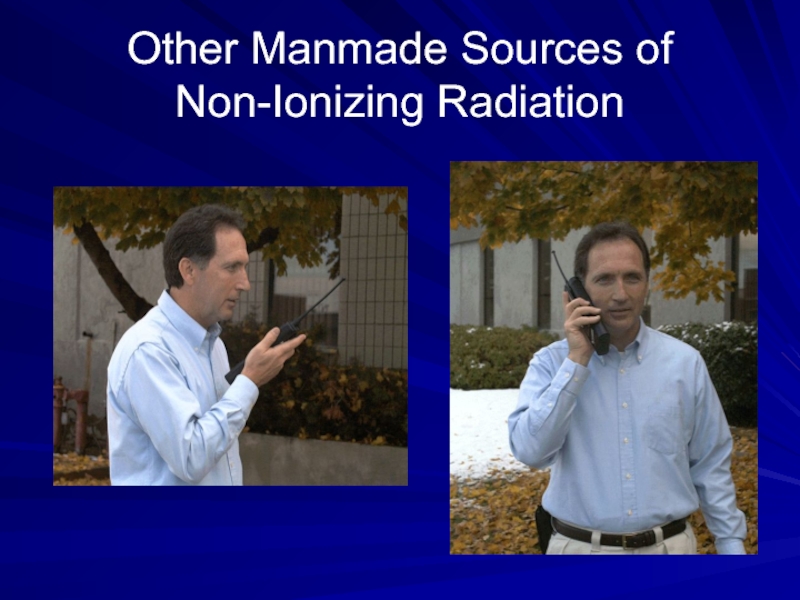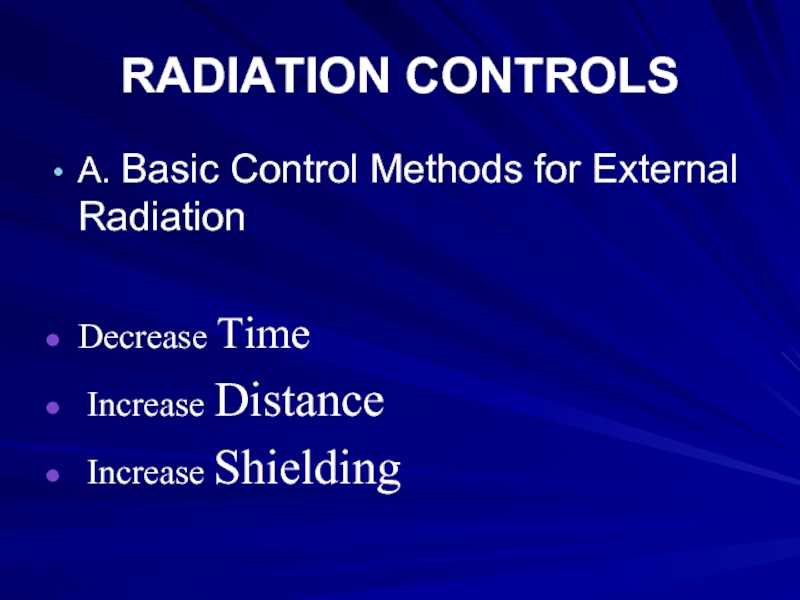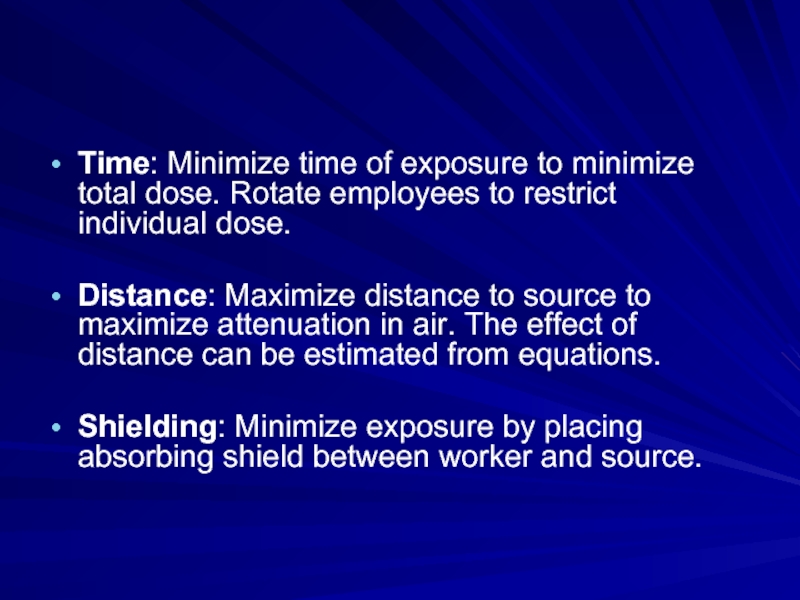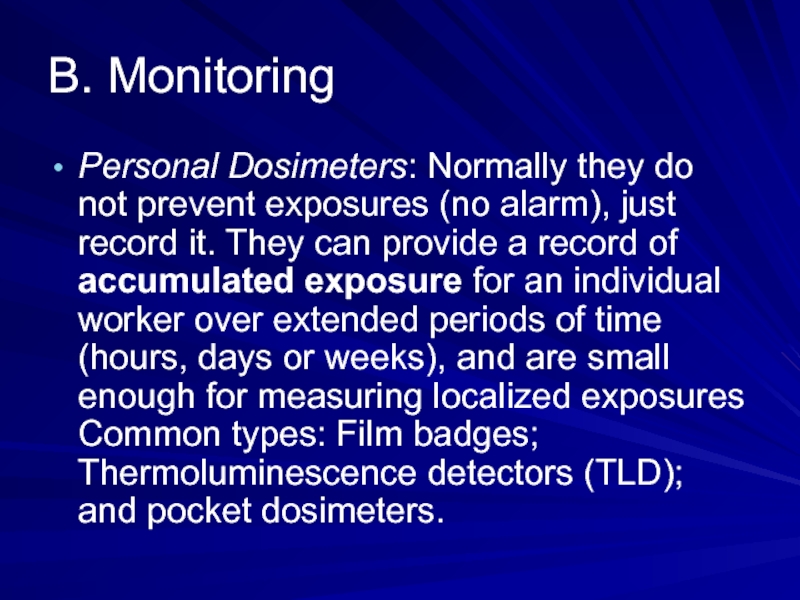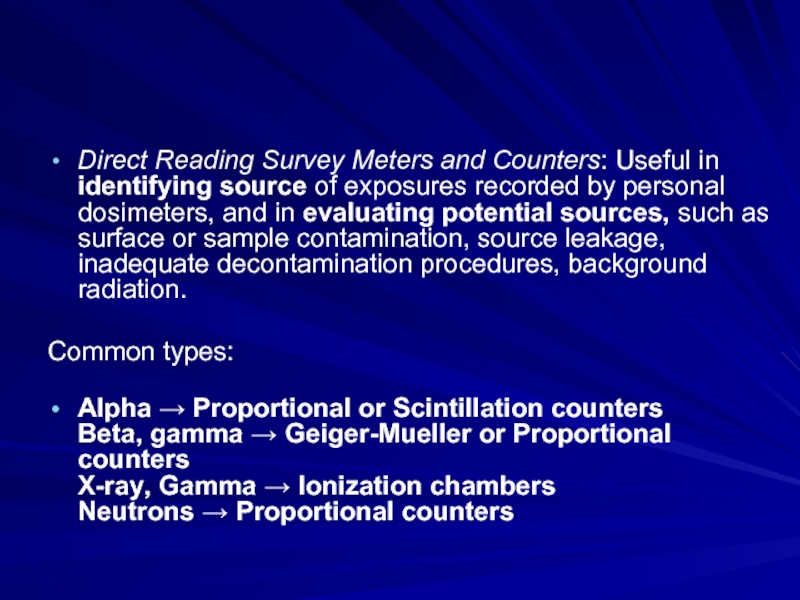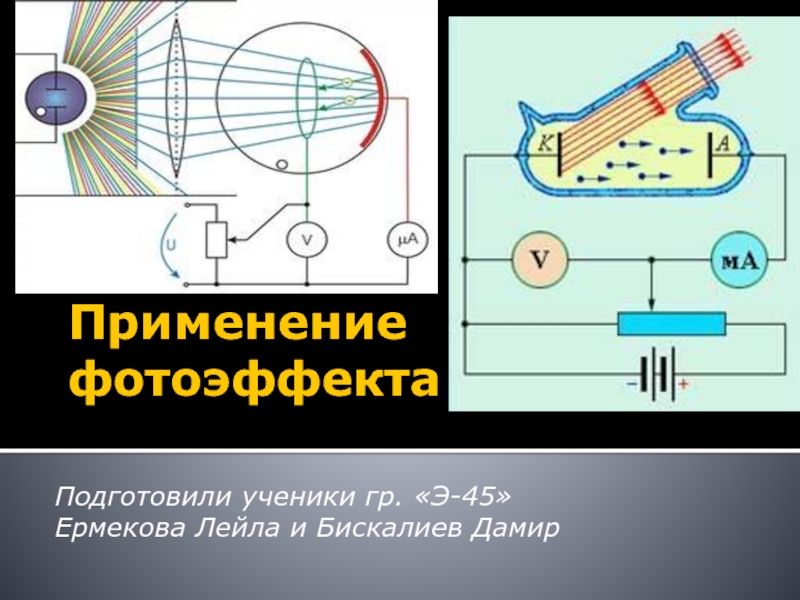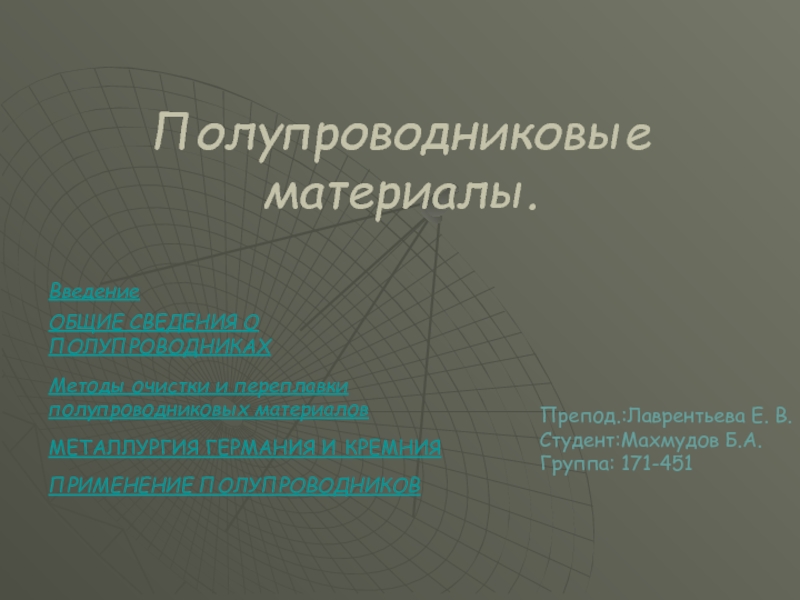- Главная
- Разное
- Дизайн
- Бизнес и предпринимательство
- Аналитика
- Образование
- Развлечения
- Красота и здоровье
- Финансы
- Государство
- Путешествия
- Спорт
- Недвижимость
- Армия
- Графика
- Культурология
- Еда и кулинария
- Лингвистика
- Английский язык
- Астрономия
- Алгебра
- Биология
- География
- Детские презентации
- Информатика
- История
- Литература
- Маркетинг
- Математика
- Медицина
- Менеджмент
- Музыка
- МХК
- Немецкий язык
- ОБЖ
- Обществознание
- Окружающий мир
- Педагогика
- Русский язык
- Технология
- Физика
- Философия
- Химия
- Шаблоны, картинки для презентаций
- Экология
- Экономика
- Юриспруденция
Radiation презентация
Содержание
- 1. Radiation
- 2. Definition of Radiation “Radiation is an energy
- 3. Forces: There are many interactions among nuclei.
- 4. Radioactivity: Elements & Atoms Atoms are composed
- 5. Basic Model of a Neutral Atom.
- 7. Radioactivity If a nucleus is unstable for
- 8. Ionization Ionizing radiation is produced by
- 13. Types or Products of Ionizing Radiation β α γ or X-ray neutron
- 14. Radioactive Atom X-ray gamma ray
- 15. The electro-magnetic waves vary in their length and frequency along a very wide spectrum.
- 19. Types of Radiation Radiation is classified into: Ionizing radiation Non-ionizing radiation
- 20. Ionizing Versus Non-ionizing Radiation Ionizing Radiation Higher
- 21. Ionizing Radiation Definition: “
- 22. Another Definition Ionizing radiation
- 23. Primary Types of Ionizing Radiation Alpha particles
- 24. Alpha Particles: 2 neutrons and 2 protons
- 25. Alpha Particles (or Alpha Radiation): Helium
- 26. Beta Particles
- 27. Beta Particles: High speed electron ejected
- 29. Gamma Rays Gamma Rays (or photons):
- 30. X-Rays X-Rays: Occur whenever an inner shell
- 31. X- and Gamma Rays: X-rays are
- 32. Neutrons Neutrons: Have the same mass as protons but are uncharged
- 35. QUANTIFICATION OF RADIATION A. Quantifying Radioactive Decay B. Quantifying Exposure and Dose
- 36. A. Quantifying Radioactive Decay Measurement of Activity
- 37. B. Quantifying Exposure and Dose Exposure: Roentgen
- 38. Half Life Calculation
- 39. Ionizing Radiation at the Cellular Level Causes
- 40. Exposure Limits OSHA Limits: Whole body limit
- 41. External/Internal Exposure Limits for Occupationally Exposed
- 43. Community Emergency Radiation Hazardous Waste Sites:
- 44. Your Annual Exposure
- 45. HEALTH EFFECTS Generalizations: Biological effects
- 46. ACUTE DOSE(RAD) EFFECT
- 47. Delayed Somatic Effects: Delayed effects to
- 48. Critical Organs: Organs generally most susceptible
- 49. Non-ionizing Radiation Definition: “ They are electromagnetic
- 50. All earth surface system components emit
- 52. Path of incoming solar radiation
- 53. Albedo: a measure of how well a surface reflects insolation
- 54. Examples on Non-ionizing Radiation Sources Visible light
- 55. Other Manmade Sources of Non-Ionizing Radiation
- 58. Effects Radiofrequency Ranges (10 kHz to
- 59. RADIATION CONTROLS A. Basic Control Methods for
- 60. Time: Minimize time of exposure to
- 62. B. Monitoring Personal Dosimeters: Normally they
- 66. Direct Reading Survey Meters and Counters:
- 68. Continuous Monitors: Continuous direct reading ionization
- 69. Elements of Radiation Protection Program Monitoring
- 70. Thank You
Слайд 2Definition of Radiation
“Radiation is an energy in the form of electro-magnetic
waves or particulate matter, traveling in the air.”
Слайд 3Forces: There are many interactions among nuclei. It turns out that
there are forces other than the electromagnetic force and the gravitational force which govern the interactions among nuclei.
Einstein in 1905m showed 2 more laws: energy/mass, and binding energy
Einstein in 1905m showed 2 more laws: energy/mass, and binding energy
Слайд 4Radioactivity: Elements & Atoms
Atoms are composed of smaller particles referred to
as:
Protons
Neutrons
Electrons
Protons
Neutrons
Electrons
Слайд 5Basic Model of a Neutral Atom.
Electrons (-) orbiting nucleus of protons
(+) and neutrons. Same number of electrons as protons; net charge = 0.
Atomic number (number of protons) determines element.
Mass number (protons + neutrons)
Atomic number (number of protons) determines element.
Mass number (protons + neutrons)
Слайд 7Radioactivity
If a nucleus is unstable for any reason, it will emit
and absorb particles. There are many types of radiation and they are all pertinent to everyday life and health as well as nuclear physical applications.
Слайд 8Ionization
Ionizing radiation is produced by unstable atoms. Unstable atoms differ
from stable atoms because they have an excess of energy or mass or both.
Unstable atoms are said to be radioactive. In order to reach stability, these atoms give off, or emit, the excess energy or mass. These emissions are called radiation.
Unstable atoms are said to be radioactive. In order to reach stability, these atoms give off, or emit, the excess energy or mass. These emissions are called radiation.
Слайд 20Ionizing Versus Non-ionizing Radiation
Ionizing Radiation
Higher energy electromagnetic waves (gamma) or heavy
particles (beta and alpha).
High enough energy to pull electron from orbit.
Non-ionizing Radiation
Lower energy electromagnetic waves.
Not enough energy to pull electron from orbit, but can excite the electron.
High enough energy to pull electron from orbit.
Non-ionizing Radiation
Lower energy electromagnetic waves.
Not enough energy to pull electron from orbit, but can excite the electron.
Слайд 21Ionizing Radiation
Definition:
“ It is a type of radiation
that is able to disrupt atoms and molecules on which they pass through, giving rise to ions and free radicals”.
Слайд 22 Another Definition
Ionizing radiation
A radiation is said to be
ionizing when it has enough energy to eject one or more electrons from the atoms or molecules in the irradiated medium. This is the case of a and b radiations, as well as of electromagnetic radiations such as gamma radiations, X-rays and some ultra-violet rays. Visible or infrared light are not, nor are microwaves or radio waves.
Слайд 23Primary Types of Ionizing Radiation
Alpha particles
Beta particles
Gamma rays (or photons)
X-Rays (or
photons)
Neutrons
Neutrons
Слайд 24Alpha Particles: 2 neutrons and 2 protons
They travel short distances, have
large mass
Only a hazard when inhaled
Only a hazard when inhaled
Types and Characteristics of Ionizing Radiation
Alpha Particles
Слайд 25
Alpha Particles (or Alpha Radiation): Helium nucleus (2 neutrons and 2
protons); +2 charge; heavy (4 AMU). Typical Energy = 4-8 MeV; Limited range (<10cm in air; 60µm in tissue); High LET (QF=20) causing heavy damage (4K-9K ion pairs/µm in tissue). Easily shielded (e.g., paper, skin) so an internal radiation hazard. Eventually lose too much energy to ionize; become He.
Слайд 26Beta Particles
Beta Particles: Electrons or positrons having small mass and variable
energy. Electrons form when a neutron transforms into a proton and an electron or:
Слайд 27
Beta Particles: High speed electron ejected from nucleus; -1 charge, light
0.00055 AMU; Typical Energy = several KeV to 5 MeV; Range approx. 12'/MeV in air, a few mm in tissue; Low LET (QF=1) causing light damage (6-8 ion pairs/µm in tissue). Primarily an internal hazard, but high beta can be an external hazard to skin. In addition, the high speed electrons may lose energy in the form of X-rays when they quickly decelerate upon striking a heavy material. This is called Bremsstralung (or Breaking) Radiation. Aluminum and other light (<14) materials are used for shielding.
Слайд 29Gamma Rays
Gamma Rays (or photons): Result when the nucleus releases energy,
usually after an alpha, beta or positron transition
Слайд 30X-Rays
X-Rays: Occur whenever an inner shell orbital electron is removed and
rearrangement of the atomic electrons results with the release of the elements characteristic X-Ray energy
Слайд 31
X- and Gamma Rays: X-rays are photons (Electromagnetic radiations) emitted from
electron orbits. Gamma rays are photons emitted from the nucleus, often as part of radioactive decay. Gamma rays typically have higher energy (Mev's) than X-rays (KeV's), but both are unlimited.
Слайд 35QUANTIFICATION OF RADIATION
A. Quantifying Radioactive Decay
B. Quantifying Exposure and Dose
Слайд 36A. Quantifying Radioactive Decay
Measurement of Activity in disintegrations per second (dps);
1 Becquerel (Bq) = 1 dps;
1 Curie (Ci) = 3.7 x 1010 dps;
Activity of substances are expressed as activity per weight or volume (e.g., Bq/gm or Ci/l).
Слайд 37B. Quantifying Exposure and Dose
Exposure: Roentgen 1 Roentgen (R) = amount
of X or gamma radiation that produces ionization resulting in 1 electrostatic unit of charge in 1 cm3 of dry air. Instruments often measure exposure rate in mR/hr.
Absorbed Dose: rad (Roentgen absorbed dose) = absorption of 100 ergs of energy from any radiation in 1 gram of any material; 1 Gray (Gy) = 100 rads = 1 Joule/kg; Exposure to 1 Roentgen approximates 0.9 rad in air.
Biologically Equivalent Dose: Rem (Roentgen equivalent man) = dose in rads x QF, where QF = quality factor. 1 Sievert (Sv) = 100 rems.
Absorbed Dose: rad (Roentgen absorbed dose) = absorption of 100 ergs of energy from any radiation in 1 gram of any material; 1 Gray (Gy) = 100 rads = 1 Joule/kg; Exposure to 1 Roentgen approximates 0.9 rad in air.
Biologically Equivalent Dose: Rem (Roentgen equivalent man) = dose in rads x QF, where QF = quality factor. 1 Sievert (Sv) = 100 rems.
Слайд 39Ionizing Radiation at the Cellular Level
Causes breaks in one or both
DNA strands or;
Causes Free Radical formation
Causes Free Radical formation
Слайд 40Exposure Limits
OSHA Limits: Whole body limit = 1.25 rem/qtr or 5
rem (50 mSv) per year.
Hands and feet limit = 18.75 rem/qtr.
Skin of whole body limit = 7.5 rem/qtr.
Total life accumulation = 5 x (N-18) rem where N = age. Can have 3 rem/qtr if total life accumulation not exceeded.
Note: New recommendations reduce the 5 rem to 2 rem.
Hands and feet limit = 18.75 rem/qtr.
Skin of whole body limit = 7.5 rem/qtr.
Total life accumulation = 5 x (N-18) rem where N = age. Can have 3 rem/qtr if total life accumulation not exceeded.
Note: New recommendations reduce the 5 rem to 2 rem.
Слайд 41
External/Internal Exposure Limits for Occupationally Exposed Individuals
Annual Dose Limits
*Effective dose equivalent
Слайд 43Community Emergency Radiation
Hazardous Waste Sites:
Radiation above background (0.01-0.02 m rem/hr)
signifies possible presence which must be monitored. Radiation above 2 m rem/hr indicates potential hazard. Evacuate site until controlled.
Слайд 45
HEALTH EFFECTS
Generalizations: Biological effects are due to the ionization process
that destroys the capacity for cell reproduction or division or causes cell mutation. A given total dose will cause more damage if received in a shorter time period. A fatal dose is (600 R)
Acute Somatic Effects: Relatively immediate effects to a person acutely exposed. Severity depends on dose. Death usually results from damage to bone marrow or intestinal wall. Acute radio-dermatitis is common in radiotherapy; chronic cases occur mostly in industry.
Acute Somatic Effects: Relatively immediate effects to a person acutely exposed. Severity depends on dose. Death usually results from damage to bone marrow or intestinal wall. Acute radio-dermatitis is common in radiotherapy; chronic cases occur mostly in industry.
Слайд 47
Delayed Somatic Effects: Delayed effects to exposed person include: Cancer, leukemia,
cataracts, life shortening from organ failure, and abortion. Probability of an effect is proportional to dose (no threshold). Severity is independent of dose. Doubling dose for cancer is approximately 10-100 rems.
Genetic Effects: Genetic effects to off-spring of exposed persons are irreversible and nearly always harmful. Doubling dose for mutation rate is approximately 50-80 rems. (Spontaneous mutation rate is approx. 10-100 mutations per million population per generation.)
Genetic Effects: Genetic effects to off-spring of exposed persons are irreversible and nearly always harmful. Doubling dose for mutation rate is approximately 50-80 rems. (Spontaneous mutation rate is approx. 10-100 mutations per million population per generation.)
Слайд 48
Critical Organs: Organs generally most susceptible to radiation damage include: Lymphocytes,
bone marrow, gastro-intestinal, gonads, and other fast-growing cells. The central nervous system is relatively resistant. Many nuclides concentrate in certain organs rather than being uniformly distributed over the body, and the organs may be particularly sensitive to radiation damage, e.g., isotopes of iodine concentrate in the thyroid gland. These organs are considered "critical" for the specific nuclide.
Слайд 49Non-ionizing Radiation
Definition:
“ They are electromagnetic waves incapable of producing ions while
passing through matter, due to their lower energy.”
Слайд 50
All earth surface system components emit radiation---the sun and the earth
are the components we are most interested in
The sun emits radiation composed of high energy infrared radiation, visible light, and ultraviolet radiation collectively known as shortwave radiation (SW)
The earth emits radiation composed of lower energy infrared radiation collectively known as long-wave radiation (LW)
The sun emits radiation composed of high energy infrared radiation, visible light, and ultraviolet radiation collectively known as shortwave radiation (SW)
The earth emits radiation composed of lower energy infrared radiation collectively known as long-wave radiation (LW)
Слайд 54Examples on Non-ionizing Radiation Sources
Visible light
Microwaves
Radios
Video Display Terminals
Power lines
Radiofrequency Diathermy (Physical
Therapy)
Lasers
Lasers
Слайд 58Effects
Radiofrequency Ranges (10 kHz to 300 GHz)
Effects only possible at
ten times the permissible exposure limit
Heating of the body (thermal effect)
Cataracts
Some studies show effects of teratoginicity and carcinogenicity.
Heating of the body (thermal effect)
Cataracts
Some studies show effects of teratoginicity and carcinogenicity.
Слайд 59RADIATION CONTROLS
A. Basic Control Methods for External Radiation
Decrease Time
Increase
Distance
Increase Shielding
Increase Shielding
Слайд 60
Time: Minimize time of exposure to minimize total dose. Rotate employees
to restrict individual dose.
Distance: Maximize distance to source to maximize attenuation in air. The effect of distance can be estimated from equations.
Shielding: Minimize exposure by placing absorbing shield between worker and source.
Distance: Maximize distance to source to maximize attenuation in air. The effect of distance can be estimated from equations.
Shielding: Minimize exposure by placing absorbing shield between worker and source.
Слайд 62B. Monitoring
Personal Dosimeters: Normally they do not prevent exposures (no
alarm), just record it. They can provide a record of accumulated exposure for an individual worker over extended periods of time (hours, days or weeks), and are small enough for measuring localized exposures Common types: Film badges; Thermoluminescence detectors (TLD); and pocket dosimeters.
Слайд 66
Direct Reading Survey Meters and Counters: Useful in identifying source of
exposures recorded by personal dosimeters, and in evaluating potential sources, such as surface or sample contamination, source leakage, inadequate decontamination procedures, background radiation.
Common types:
Alpha → Proportional or Scintillation counters Beta, gamma → Geiger-Mueller or Proportional counters X-ray, Gamma → Ionization chambers Neutrons → Proportional counters
Common types:
Alpha → Proportional or Scintillation counters Beta, gamma → Geiger-Mueller or Proportional counters X-ray, Gamma → Ionization chambers Neutrons → Proportional counters
Слайд 68
Continuous Monitors: Continuous direct reading ionization detectors (same detectors as above)
can provide read-out and/or alarm to monitor hazardous locations and alert workers to leakage, thereby preventing exposures.
Long-Term Samplers: Used to measure average exposures over a longer time period. For example, charcoal canisters or electrets are set out for days to months to measure radon in basements (should be <4 pCi/L).
Long-Term Samplers: Used to measure average exposures over a longer time period. For example, charcoal canisters or electrets are set out for days to months to measure radon in basements (should be <4 pCi/L).
Слайд 69Elements of Radiation Protection Program
Monitoring of exposures: Personal, area, and
screening measurements; Medical/biologic monitoring.
Task-Specific Procedures and Controls: Initial, periodic, and post-maintenance or other non-scheduled events. Engineering (shielding) vs. PPE vs. administrative controls. Including management and employee commitment and authority to enforce procedures and controls.
Emergency procedures: Response, "clean-up", post clean-up testing and spill control.
Training and Hazard Communications including signs, warning lights, lockout/tagout, etc. Criteria for need, design, and information given.
Material Handling: Receiving, inventory control, storage, and disposal.
Task-Specific Procedures and Controls: Initial, periodic, and post-maintenance or other non-scheduled events. Engineering (shielding) vs. PPE vs. administrative controls. Including management and employee commitment and authority to enforce procedures and controls.
Emergency procedures: Response, "clean-up", post clean-up testing and spill control.
Training and Hazard Communications including signs, warning lights, lockout/tagout, etc. Criteria for need, design, and information given.
Material Handling: Receiving, inventory control, storage, and disposal.
